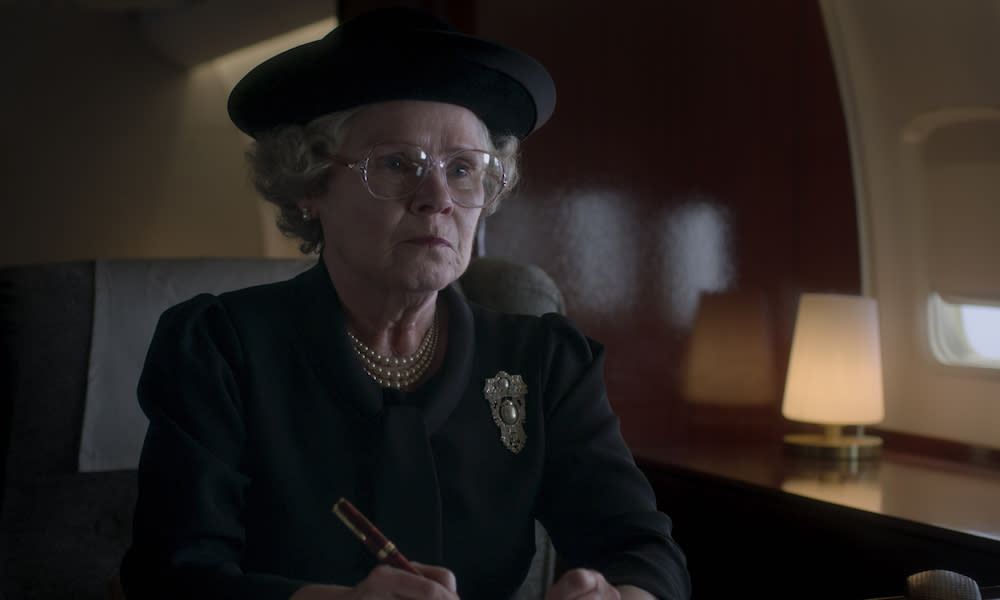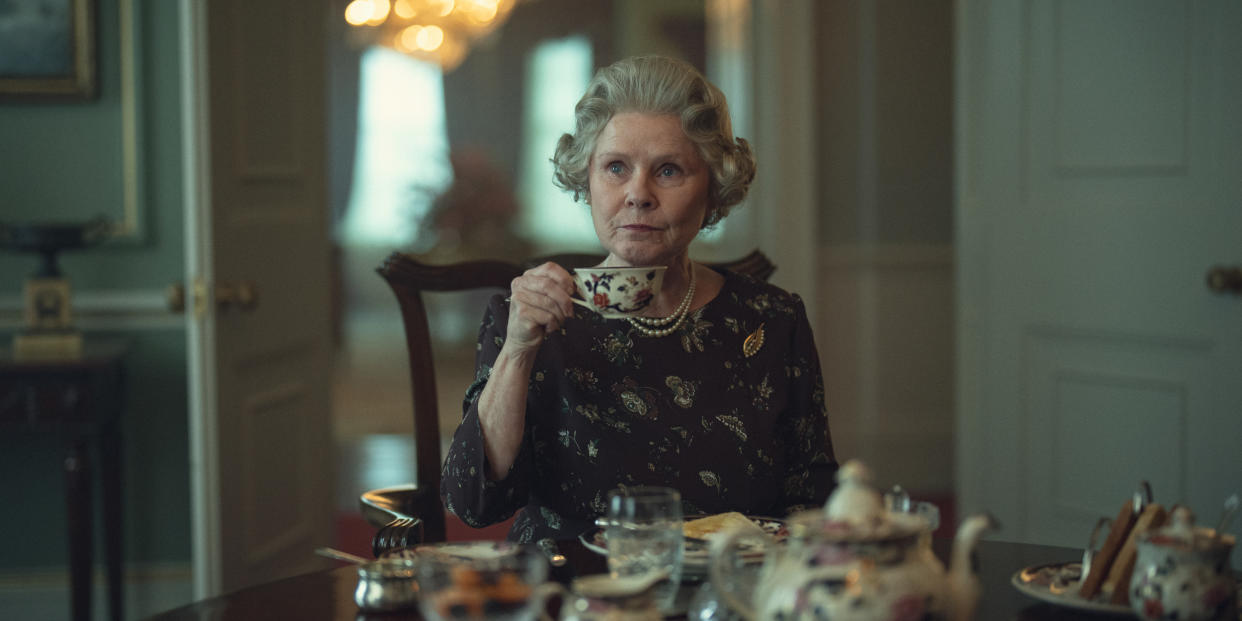How ‘The Crown’ Shot Its Emotional Final Scenes With Imelda Staunton, Olivia Colman and Claire Foy

SPOILER ALERT: This article contains spoilers for “The Crown” Season 6, streaming on Netflix now.
The series finale of “The Crown” is set in 2005, a full 17 years before Queen Elizabeth II’s death. But as the show’s creator, Peter Morgan, told Variety earlier this year, he felt compelled to honor the Queen’s real-life passing within the show.
More from Variety
“We’d all been through the experience of the funeral,” he said. “So because of how deeply everybody will have felt that, I had to try and find a way in which the final episode dealt with the character’s death, even though she hadn’t died yet.”
The result is an emotional final five minutes, which sees an 80-year-old Elizabeth, played by Imelda Staunton, contemplating her life in St George’s Chapel, where she will eventually be laid to rest. She imagines younger versions of herself — resulting in cameos from the role’s previous incumbents, Olivia Colman and Claire Foy — as well as picturing her coffin. Finally, she makes the lengthy walk across the floor of the chapel, toward the door and into the light.
The scenes, which were filmed at York Minster Cathedral in April, were directed by Stephen Daldry (who also directed the first two episodes of the series) with Adriano Goldman as director of photography. Goldman, who has worked on the show for eight years, says he was thrilled Daldry returned for the last episode: “It’s full circle.”
Hours after the finale dropped on Netflix, the cinematographer sat down with Variety to discuss how the team shot those poignant final scenes.
Where did you and Stephen start in terms of planning the final scenes, and how prescriptive was Peter’s script?
It was much more Stephen insisting that we should absolutely have the three queens in the last episode. And then both Stephen and Peter went back to the script, and Peter rewrote a couple of scenes. Stephen loves magical realism. So the idea of turning something that is based on real characters and true events — if you can add a little bit of magic, that’s very much Stephen, even if it’s not actually written.
Earlier on in the same episode, [the Queen] watches some family Super 8 movies. There was a version [of the final episode] where instead of actually meeting the former queens almost physically she would turn the projector on and by magic — by VFX or some sort of post-production — she would literally dive into the screen, into her memories. And that would give her the opportunity to be with the other queens, so it would be even more dreamy than it is now. It would be like inside a different universe: Physically turn the projector on, and that inspires her to travel back in time and then have a chat with her former self at different ages. But that would be a massive aesthetic step for a show like “The Crown.” And then little by little I think we stepped back into something that would feel a little bit more real. Stephen found a way to have the conversations within scenarios or sets that belong to the Queen’s life.

Were Olivia and Claire there in person for the final scene in the cathedral?
They were. Again, going back to the VFX version that we once considered, we turned [the final version] less and less VFX-like. So everybody was there in person for the final scene. That was a struggle in itself in terms of the three queens’ schedules, and who’s available, who’s not available, what’s the best day to have them all together, how much time we’re going to have with the three of them together. It’s not much, so we have to simplify the way they appear.
So they were there physically. But that choir nave where the scene takes place, it’s a narrow one. So in order to light them properly, to make them look beautiful and appealing and royal, that was a very specific challenge for me because I didn’t have enough space on the sides for lighting sources.
Did you plan the shot where Imelda goes in and out of focus as she turns her head first to Olivia and then Claire behind her?
I knew that was something Stephen really wanted. He wanted to be able to have them in different focal planes that would force us to go with Imelda’s head and find the other queens. We had discussions on the day if we could, even on that tableau shot, somehow split the screen in two, but there would have had to be some sort of VFX trick.
Then we decided on the day, let’s just do what the lens tells us to do. So you go to Olivia and they both get sharp, you come back to Imelda — and then you go to Claire. Your eyes are going to the right direction anyway because she’s guiding you over each shoulder. They were there physically, we just had to play a little bit of depth of field to make them a little bit softer to justify the head turn.
Just before that scene, the Queen imagines her funeral. Did you use a real coffin?
It was an actual coffin. You don’t see it because a flag covers it.
When the coffin was brought in for the shot, did it change the atmosphere on set?
I think it changed for Imelda. I think Imelda felt it. It was a very, very emotional, and very specific moment about the Queen’s life and concerns. Age is a subject throughout the episode, right? Now we know she’s 80. At the very beginning, Prince Philip says to her face: “You’re 80.” So you know it’s coming. It’s funny how they are effectively discussing life and death. It’s such a beautiful episode, it was so emotional. The fourth episode [following Diana’s death] was another one. We cried so many times on set with the ghost scenes.

Then there’s the very final scene, where the camera is perched high up as the Queen walks across the nave of the cathedral toward the door. Was the camera on a balcony?
Yes. That’s the same balcony that a few minutes earlier you see the piper. So when she spots the piper on that mezzanine, that’s the same position we were — looking to the other side of the cathedral.
When did you shoot that final scene?
We shot the very last shot on the very last day of principal photography. It was in itself very emotional for all of us. We planned for that: “Let’s just leave the last shot for the end.” Also, that was very much related to sunset and the fact that I knew that in the afternoon — if it was a sunny day — I was going to get the shafts of light hitting the right side of the cathedral.
So that’s real sun coming in through the cathedral windows as she walks toward the door?
That’s real sun. [Because of the cathedral’s size] I couldn’t have the amount of light sources outside that I’m used to, so I had to rethink my lighting process. I had more lights inside the building than outside, bouncing on those walls just to create a soft ambience.
How many takes did you do for that final shot?
Not many, maybe three. We were running out of time.
You would have lost the light presumably as well?
Yes. So you’re running against the clock, and you’re running against your work day. But I mean, it was just a beautiful, happy coincidence that the sun came out. The whole thing was really inspiring.
What about the light shining through the door — was that production lighting?
It was, but it was a very bright day. It’s a massive door — it doesn’t look that big because the cathedral is so immense — but I knew that the sun was setting on that side of the building anyway. So I knew that I can see the sun hitting the columns inside. We had a big green screen outside because we didn’t know if we wanted to see outside or not. You actually ended up not seeing much because of the high angle. I had a [light] source, but the sun won basically in the end.
Who opened the door?
A PA.
Imelda’s costume in that scene is almost the same color as the cathedral floor, and as she gets further away from the camera she almost blends into it. Was that an issue or was it deliberate?
I never saw it as a problem. I loved when I saw that top shot for the first time. Costume decisions were taken way before we knew Yorkshire cathedral was even going to be the location. That’s the dress she was actually wearing for Camilla and Charles’ ceremony. I don’t think we would ever question that. Once it’s there, you just you have to embrace it, and you do. And I think that makes her look even more like some sort of a ghost. She’s almost floating on that white floor, and it’s just magical. It’s absolutely real. There’s no SFX or VFX at all for that shot, but it looks magical and surreal.
The final scene was shot in April, not long after the real Queen died. Did you take any inspiration from the funeral?
Not visual inspiration, no. But of course, I was very moved when she died. We were in Barcelona, and we were supposed to shoot the next day — that was going to be our first day of principal photography, and we were just told it’s not happening. In a sign of respect, we’re not going to shoot it. And then when you finish the season, you feel so somehow attached and connected to the story, that I think that’s part of the reason I think Imelda felt it when she saw the coffin on stage. It was so recent for all of us that there’s no way you don’t somehow feel sad again.
This interview has been edited and condensed.
Best of Variety
Sign up for Variety’s Newsletter. For the latest news, follow us on Facebook, Twitter, and Instagram.
